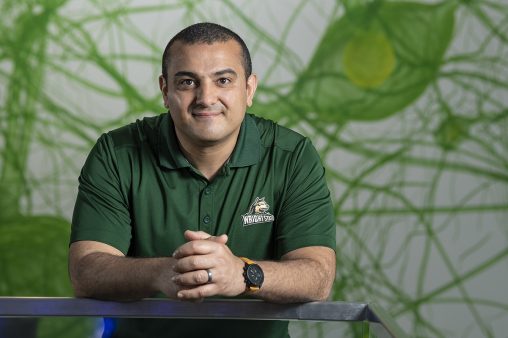Excerpt

Sherif Elbasiouny, professor of neuroscience, cell biology and physiology and director of neuroengineering education and research at Wright State, will lead a research project examining the neural mechanisms underlying weakness in aging.
Wright State is one of three Ohio universities involved in a study that could revolutionize the way we think about aging.
The scientists are studying the role of the nervous system in the way older people have difficulty and become weaker in doing basic tasks as they get older, such as walking, performing household chores and even feeding themselves. That’s what the scientists refer to as weakness in aging.
“We’re not saying that nothing is happening at the muscle,” said Sherif Elbasiouny, a professor of neuroscience, cell biology and physiology, director of neuroengineering education and research at Wright State. “We’re saying that what is really more critical is the changes that are taking place in the nervous system itself.”
Elbasiouny, one of the lead researchers, is working with William Arnold, a neurology professor at Ohio State, and Brian Clark, a professor of physiology and neuroscience at Ohio University. The three have worked together before.
They will examine changes in the brain and nervous system affecting weakness in aging with a five-year, $3 million grant from the National Institutes of Health. The NIH rarely gives out grants this large unless the topic could be groundbreaking. Wright State has about half of the funding.
Recent data shows muscle plays a lesser role in aging than previously thought, Elbasiouny said. He said there is little research about the changes in the nervous system during aging. Age-related weaknesses were previously attributed primarily to loss of muscle mass.
People also experience the phenomenon differently. Some never experience weakness in aging, but others face the problem much earlier.
Clark, who will be conducting experiments involving humans at his lab, said the goal is to understand more about the mechanics of motor neurons in aging.
“The overarching goal of this work is to understand the role that the health of the motor neuron plays in age-related muscle weakness and mobility limitations,” Clark said.
Elbasiouny said the research has the potential to identify early neural biomarkers for weakness and develop new interventions to enhance strength and function in older adults.
“However, the work at Wright State specifically could additionally identify novel therapeutic targets for treating or preventing weakness in aging,” he said.
Elbasiouny cautioned the research they are doing is going to be the beginning of more work in the area. The first step is to understand what is happening.
“I want to make sure to also let people know, so that they are not expecting that in a year or two we will have drugs that will reverse aging,” Elbasiouny said.
View the original story at daytondailynews.com

 Milling around
Milling around  Wright State recognizes Nursing Professor Kim Ringo for advancing international student success
Wright State recognizes Nursing Professor Kim Ringo for advancing international student success  Wright State honors graduating students for distinguished doctoral dissertations
Wright State honors graduating students for distinguished doctoral dissertations  Top 10 Newsroom videos of 2025
Top 10 Newsroom videos of 2025  Museum-quality replica of historic Hawthorn Hill donated to Wright State
Museum-quality replica of historic Hawthorn Hill donated to Wright State 